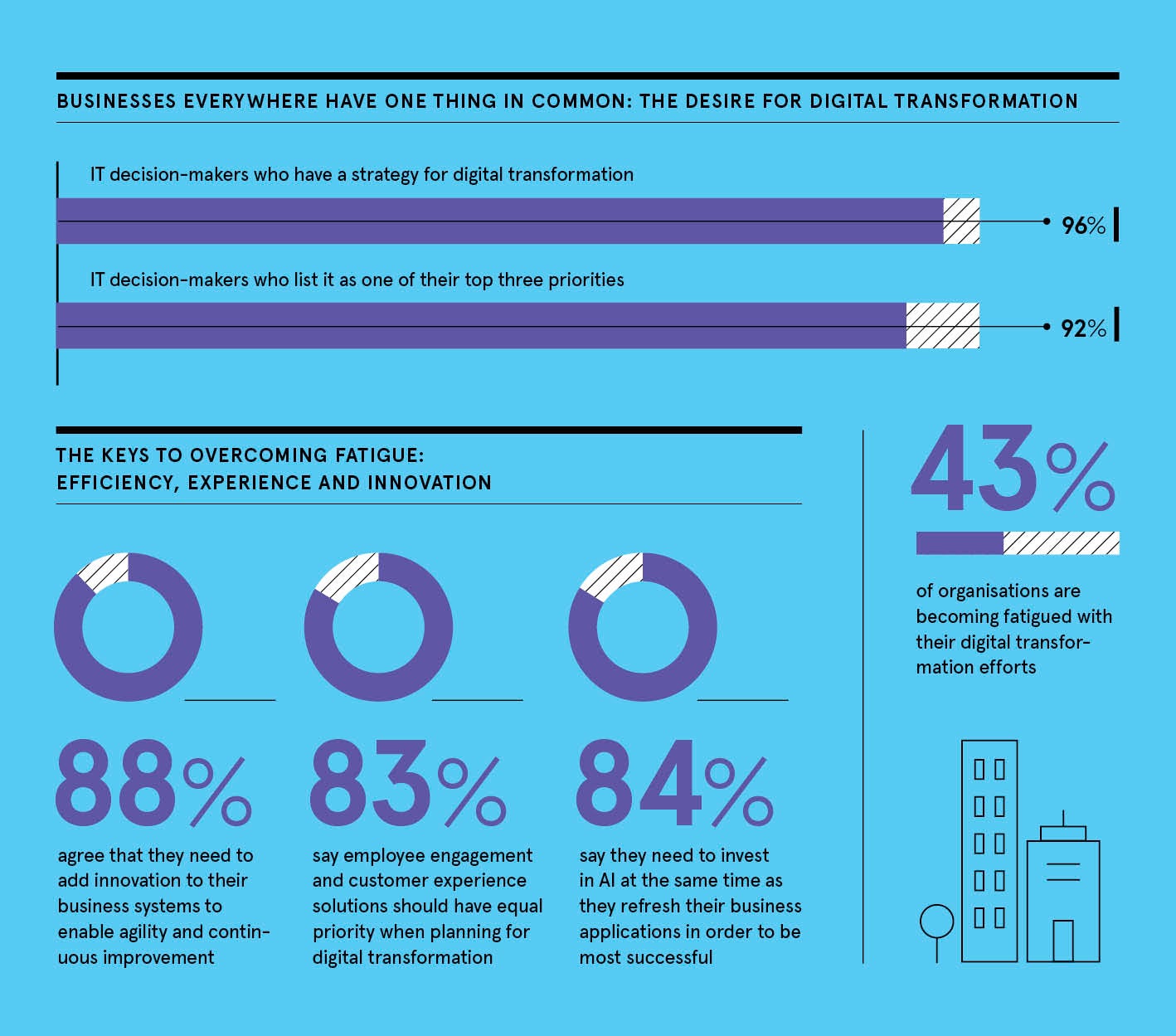Companies that substantially complete their transformations and become future ready tend to enjoy margins 16 percentage points higher than their industry’s average, according to MIT Center for Information Systems Research.
However, for many businesses, achieving a future-ready state proves to be challenging. A new paper by the transformation consultancy Avanade shows that many stitch together legacy systems, or have highly siloed departments and an array of technology systems in place, leading to profits stagnating at up to 5.1 percentage points below the industry margin.
There is a renewed urgency to transform successfully as those companies that do so are consistently delivering richer growth margins and stronger customer satisfaction scores.
For transformations to be effective, they need to put customers at the centre, but this focus alone is not enough. To achieve high customer satisfaction, companies need to have employee experience as a core element of their transformation, according to Annette Giardina, UK and Ireland business applications lead at Avanade.
“We know that employee satisfaction leads to much better results for customers, so the technology they use has to be flexible, modern and helpful instead of getting in the way,” she says. “Technology should replace the mundane tasks so staff can focus on value-added activity, which in turn is more satisfying.”
Thanks to technological advancements, including on-demand services, storage and analytics, we can leverage data in very granular ways to help transform business
Avanade’s research shows that 83 per cent of business leaders planning for digital transformation increasingly recognise the importance of both employee engagement and customer experience.
Transformations also require an effective end-goal, and a clear roadmap of how to get there, if they are to be realistically achievable and sustainable. “Businesses need a ‘north star’ to aim at over the next three to five years. Their roadmap must be flexible and they must be confident to adapt it to meet changing business priorities while still remaining focused on the strategic goal,” Ms Giardina explains. “When they have this plan and can see what the future holds, they can be the future.”
The strategies must be focused foremost on people and processes, and underpinned by innovation, technology and actionable insights. “In essence, these transformations exist as a pyramid, with people on one side and processes on the other, and technology underpinning it all. Technology is not the driver of these programmes, it is the enabler. Without it the pyramid can still stand, but without a focus on the people and the processes it collapses,” says Ms Giardina.
The unwieldy nature of many older businesses, or those that have grown through acquisitions, makes achieving this balance challenging. “Companies often end up in siloed teams, such as back-office planning, sales and service, or innovation, and they can’t easily move in one unified direction,” explains Bernd Weidenmüller, head of Avanade’s business applications unit in Europe.
By combining the ability to support staff working from anywhere, with the Microsoft Dynamics cloud, analytics, machine-learning and artificial intelligence, businesses can become powerfully improved. “Thanks to technological advancements, including on-demand services, storage and analytics, we can leverage data in very granular ways to help transform business,” adds Mr Weidenmüller.
“In the past, people had specific use-cases in mind and decided on the data required, whereas now organisations can preserve data well ahead of future use, making it available for machine-learning and predictions in ways they don’t even envision at the time of data creation. This is a big shift in thinking.”
Initial results on companies’ data insights projects are now achievable within weeks, instead of the six to nine months traditionally needed with legacy, on-premise enterprise resource planning systems. The combination of Avanade’s scaled delivery, and Microsoft’s unique extension model for cloud-based enterprise resource planning, means companies can quickly get the benefits of the cloud while still being able to modify their systems around unique business needs.
Indeed, an advanced companies’ innovation-based approach to transformation is beginning to unlock much faster and wider change, Mr Weidenmüller notes. “It is essential that teams can test new ideas and when those ideas work that there is a path to move from proof of concept to pilot, and then to a broader roll out. The most future-ready organisations recognise not every idea will produce immediate business results, but they understand the need to create a culture of experimentation and innovation at will,” he says.
Avanade works with organisations across industries to develop such innovative transformation cultures, to shape their strategies and execute consistently on their plans with regular and measurable return on investment. It has the end-to-end capabilities to make sure businesses can become future ready now, ensuring they build operational efficiencies, invest in customer and employee experiences, and create continual innovation.
Avanade’s leader position in the Forrester Wave for Microsoft Dynamics 365 Services, and its recognition with Accenture as an IDC MarketScape leader in worldwide Microsoft implementation services, provides strong confidence for clients in the success of the complex and business-critical changes they are considering.
“The companies that have a clear end-goal, and a realistic and adaptable roadmap to get there, regularly succeed in delivering real improvements to profitability, and customer and employee satisfaction,” Ms Giardina concludes. “This sets them a mile ahead of the competition.”
To find out more about planning and delivering successful transformation for consistent competitive advantage, please visit www.avanade.com/futurereadynow

